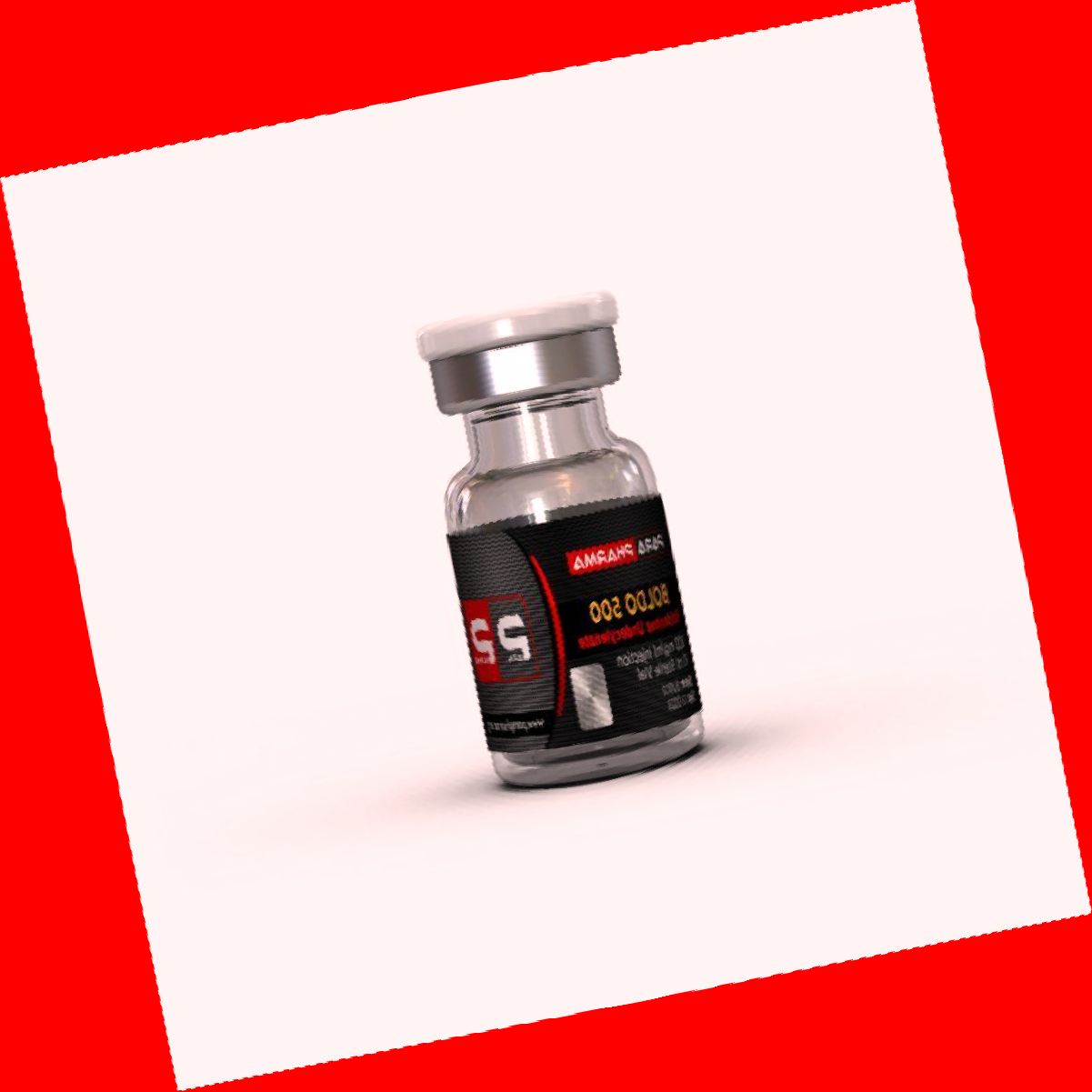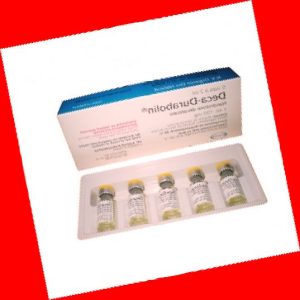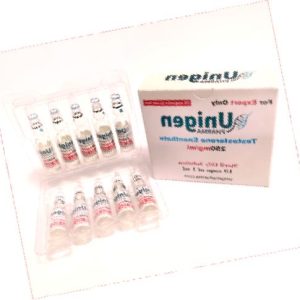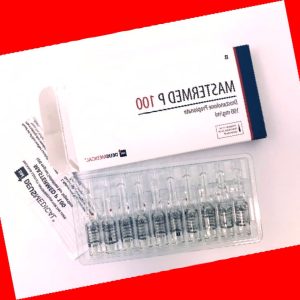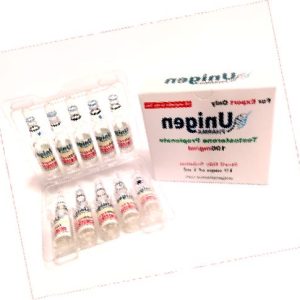Description
Boldo 500
Boldenone is Brother of “methane”
A strange thing, drugs, without which life overseas “pro” is basically unthinkable, for a long time, bypassed our market as a distant side. No, we certainly knew what “boldenone” is and “what it is eaten with”, but only in theory.
As for the practical application of this, from many points of view, unique, drug, it was not necessary to talk about it – sporadic deliveries of Colombian “Ganabol” to us, not to mention its even more extravagant Australian or Mexican counterparts, have not allowed to create the necessary basis. Thank God, now are more favorable times.
Purely veterinary drug
If we do not take into account the division of drugs, which is far from objectivity, for which there is an appropriate definition in English – “drug enhancement”, that is, “drug enhancement” – into “androgenic” and “anabolic”, therefore all AAS can be divided into two large groups: created for use in traditional (“human”) pharmacology and veterinary drugs. However, even here, the division is often more than arbitrary: oxandrolone, created specifically for use by “human” women and children, is used successfully in veterinary medicine, the same can be said of oxymetholone, stanozolol, la most nandrolone and testosterone esters.
There are, however, specific esters: laurate and sliver phenylpropionate in the case of nandrolone or acetate in the case of trenbolone, produced only for use in veterinary medicine. But they were created only to modify the pharmacokinetics of “human” drugs – to achieve slower entry into the blood in the case of the first two esters (which is important for small animals) or faster in the third. Otherwise, such drugs did not differ from the usual ones.
No, obviously there is a difference in the tolerances for the purity of the manufacturing process and, therefore, the purity of the final product, but for the most reputable veterinary companies they do not differ much from the requirements adopted in conventional pharmaceutical establishments. Another difference is the higher concentration limit allowed for the active ingredient for veterinary drugs.
But as far as boldenone is concerned, this drug was created only – exclusively – for use in animal husbandry. By the way, due to its characteristics, which we will discuss below, it is an ideal anabolic steroid for almost all animals, from cows to dogs, despite the significant differences in their metabolism. For these same characteristics, boldenone has proved to be very effective in strength sports, although I emphasize once again that it was created for animal husbandry, that is, to increase the mass of creatures significantly different from man in terms of metabolism. It is so beautiful that now it is not customary to remember its “vet” origin in a decent society.
And to learn a new drug better for us, let’s see how it looks like already familiar anabolic steroids and how it differs from them.
Boldenone and Methandrostenolone
Already at first glance, even if not very close, to the molecules of methandrostenolone and boldenone undecylenate, it is seen that not only are they similar. If we discard the methyl group in the seventeenth position in the first case and the ether chain in the same position in the second, then these molecules will become absolutely identical. I must admit that this identity confused me for a long time, not only me but many experts in the field of sports pharmacology, who considered boldenone an injectable analogue of “methane”. Indeed, this is very, very far from the truth.
The methyl group at position 17 changes the spatial structure of the methandrostenolone molecule very strongly and equally strongly, one could say dramatically, changes the properties of the drug. Furthermore, it should be borne in mind that “methane” loses this same methyl group with great difficulty – in two or even three passes through the liver. Under the influence of aromatase, methandrostenolone is converted to 17-methyl-estradiol, and boldenone to weaker estradiol. That is, despite the fact that boldenone should, in theory, aromatize better, the “rating” of its aromatization is much lower than the “rating” of “methane” itself – this is the first difference between drugs. The second, no less important, is the almost total inability of methandrostenolone to stabilize (activate) the androgen receptor. The culprit here, again, is the infamous methyl group.
In fact, the only thing that indicates a close relationship between boldenone and methandrostenolone is its ability to stimulate appetite. By the way, this makes boldenone a desirable “participant” in mass harvest cycles, although the use of its cheaper “brother” is much more preferable here due to a marked tendency to aromatization.
Boldenone and testosterone
Boldenone is similar to testosterone: the difference between their molecules is only in the presence of an additional double bond between positions 1 and 2 (ring A). But this difference makes this drug universal – thanks to the aforementioned double bond, boldenone is practically not subject to the action of the enzyme 5 -? – reductase. Let me remind you that 5 -? – reductase promotes the conversion of testosterone into the much more potent dihydrotestosterone (DHT). DHT not only stabilizes the androgen receptor better, but differs to some extent from testosterone in its properties. So we can say that 5 -? – reductase modifies the properties of the original substance.
Boldenone can be considered a softer version of testosterone. Indeed, their behavior in the human body, to some extent, appears to stabilize the androgen receptor well, both of which have non-genomic activity.
Boldenone and nandrolone
But the closest in its properties to boldenone, oddly enough, turned out to be nandrolone. With all the diversity of the molecular structure of these two drugs, both boldenone and nandrolone have approximately the same tendency to aromatize (although, of course, the difference is that the conversion of nandrolone to estradiol occurs without the participation of the aromatase enzyme). Furthermore, the stabilization time of the androgen receptor for these drugs is approximately the same. Many experts recommend nandrolone and boldenone as interchangeable drugs and consider their simultaneous use not entirely appropriate. In my opinion, this is not entirely justified, and here’s why.
As you may remember, the aforementioned 5 – enzyme? – reductase converts nandrolone to dihydronandrolone – a much weaker substance in regards to the activation of androgen receptors. That is, boldenone, which is not subject to transformation with the help of 5 -? – reductase, it can be considered a priori a more powerful drug than nandrolone. Furthermore, boldenone has non-genomic activity, although not as clearly as in its “brother” methandrostenolone, which is not even a trace in nandrolone. This is another benefit to the “brainchild of the veterinary industry”.
On the other hand, nandrolone has a marked progestogenic activity, which allows it to outperform boldenone in terms of weight gain, although not as significantly. To improve the “mass gain component” of boldenone, it is customary in veterinary practice to combine it “as part of a drug” with a substance such as methandriol dipropionate; this combination will be discussed below.
Preparations on our market
Today, there are three drugs on our market that contain boldenone undecylenate as an active ingredient. The first two can be considered analogous, they differ only in the packaging and concentration of the active ingredient. These are Boldesten-50, produced in two milliliter vials, the concentration of the active substance in the preparation is 50 mg / ml and Boldesten-100, the release form here is already a 5 ml bottle, and the concentration of the active substance la substance is 100 mg / ml. The third drug is the aforementioned combination of methandriol propionate (50 mg / ml) and boldenone undecylenate (50 mg / ml). The name of the drug is Meprobolone and it is produced in exactly the same bottles as Boldesten-50.
Application practice
In principle, boldenone can also be used in “mass harvesting” cycles, but such use of a drug that is not subject to aromatization and has no progestogen activity may seem inappropriate. Although it is possible to achieve significant mass gains by combining boldenone with “long-lasting” testosterone, enanthate, for example. Here, the boldenone property will have to increase appetite.
But the main purpose of boldenone is “drying”, although, again, don’t forget the drug’s ability to increase appetite. Since it is practically not subject to aromatization and does not show progestogen activity, in the case of its use it is possible to avoid the accumulation of water.
Often the drug is used as a substitute for nandrolone in the second half of the cycle – it does not suppress endogenous testosterone production as much as nandrolone. An interesting property of boldenone is that it stimulates the release of erythropoietin in the kidneys, which ultimately leads to an increase in red blood cells. This property is important for representatives of those sports in which the athlete’s endurance is at the forefront. However, for bodybuilders, this property is not so insignificant, if we remember that one of the mechanisms of muscle growth is based on an increase in the number of capillaries in the muscle. And the increase in vascularity, especially on the eve of competition, is an important thing.
And the last thing. What undoubtedly “ruins” boldenone is its extra long and super heavy ethereal chain. Not only is the drug included very slowly in the work, but also more than a third of the weight of the drug falls on the non-functioning “ballast”. The inaccuracy of the existence of boldenone in the form of undecylenate has been noted for a long time, but only recently began to synthesize substances such as boldenone acetate and boldenone propionate. So far, acetate and propionate versions of this, of course, the most interesting drug are only produced in test labs, but I’m sure it’s not far off the time when boldenone acetate and boldenone propionate will appear on our market.
Side effects
Boldenone has virtually no side effects, at least for men. The production of its own testosterone by the drug itself also does not suppress much.
Dosage
Typical dosages of boldenone undecylenate range from 300 to 800 mg per week. 300 mg for experienced athletes is still too little, it makes sense to adhere to this dosage only when combining boldenone with other androgens. “Working” can be considered a dosage of about 600-800 mg of the drug. For starters, 150-200 mg of boldenone per week can be considered a suitable dosage. The same dosages are acceptable for representatives of powerlifting (except for heavy categories) and other sports that do not impose greater requirements on the weight of the athlete.
Boldenone has a very long half life and can be injected weekly. Also, they should be done weekly, but not more often – this is the only way to quickly get a cumulative effect. Based on the fact that the drug is very slowly included in the work, during the first two weeks of use, the dosage should be increased from one and a half to two times.
Combination with other drugs
If you still decide to use boldenone to gain muscle mass, it is best to combine it with injections of testosterone enanthate or Sustanon. For “more credibility” in the combination, you can add oxymetholone.
For drying, boldenone’s main “partners” are trenbolone or stanozolol; you can use a combination of all three drugs. Experienced athletes can try “dry” and on testosterone propionate, here too the use of boldenone will be very appropriate.
Application by women
With prolonged use of high doses of the drug, virilization phenomena may appear, i.e. increased growth of hair on the face and body. But this is with long-term use and high doses. Although this characteristic of the drug should not be underestimated, dosages of the order of 100-200 mg per week for 4-5 weeks are unlikely to lead to virilization. It is recommended to use Boldesten-50 in this case with a lower concentration of the active substance in the solution.
A few words about methandriol
And at the end of the topic, I would like to talk about another “participant” in a complex drug called “Meprobolone” – methandriol dipropionate.
Contrary to popular belief about methandriol’s exceptional anabolic abilities, it practically has none. Also, methandriol is not an anabolic steroid, it is a prohormone, one of the forms of androstenediol. More specifically, the drug is called 5-androstene-3β-diol, better known as 5AD. At the same time, it is not known from whose light hand Methandriol has been attributed exceptional anabolic abilities, comparable to the anabolic abilities of … testosterone! Let’s see how right such a statement can be.
To become active, any prohormone must be converted into the hormone itself. In this case, methandriol or 5AD must be converted to testosterone and only then do they begin to act. What proportion of methandriol do you think is converted to testosterone? You’ll never guess – up to 0.19%! That is, the yield of one gram of 5AD per week will be comparable to the yield of 2 mg of testosterone over the same period. Tell me, have you seen many athletes gain impressive mass on two milligrams of testosterone per week? Personally I have never met such people.
What practical benefit can such a weak drug derive from? It turns out that perhaps – methandriol is an estrogen receptor agonist, that is, it exhibits estrogenic activity without being converted to estradiol. As you remember, estrogen has many beneficial traits for strength sports athletes: it helps in the accumulation of glycogen by cells and stimulates the secretion of growth hormone and IGF-1 and upregulates androgen receptors. Those on anabolic steroids that are unaffected by the aromatase enzyme, or that do not exhibit progestin or estrogenic activity on their own, are inferior to their “more advanced counterparts” for gaining muscle mass. To compensate for this lack of non-aromatizing steroids, methandriol is used.
Another useful feature of methandriol is that it partially prevents the deactivation of mesterolone (Proviron) and drostanolone, which occurs through their conversion into 5α-androstenes under the influence of the 3α-hydroxysteroid dehydrogenase enzyme. However, in the case of drostanolone, the combined use of this steroid with methandriol will not give any particular benefit – drostanolone is used exclusively at the “drying” stage and methandriol has a marked ability to accumulate water due to its inherent estrogenic activity.
Methandriol also has such a useful feature – an increase in the synthesis of leukocytes. This feature of the drug will be useful for people with an increased tendency to morbidity, especially during a low-calorie diet.
The estrogenic activity of methandriol, which in a certain period will become excessive and lead to unpleasant consequences, such as excessive accumulation of water, fat deposits, or even gynecomastia, cannot be overcome with the help of aromatase inhibitors (Arimidex ). Estrogen receptor blockers (Clomid or tamoxifen) can help here. The drug appears to have no other “side effects”.
In order for the estrogenic activity of methandriol to be positive and not harmful, its daily dose of 50 mg should not be exceeded. Usually, methandriol is already produced in combination, as a rule, with boldenone; if it is found in its pure form, it is very rare. Considering the half-life of methandriol dipropionate, equal to two or three days, the injections of the combined preparation should be given exactly at this frequency (2 ml of “Meprobolone” once every two days or 3 ml once every three days). Testosterone can also be added to the “boldenone + methandriol” combination – so the combined drug will be able to demonstrate its ability to increase muscle mass to a greater extent.












